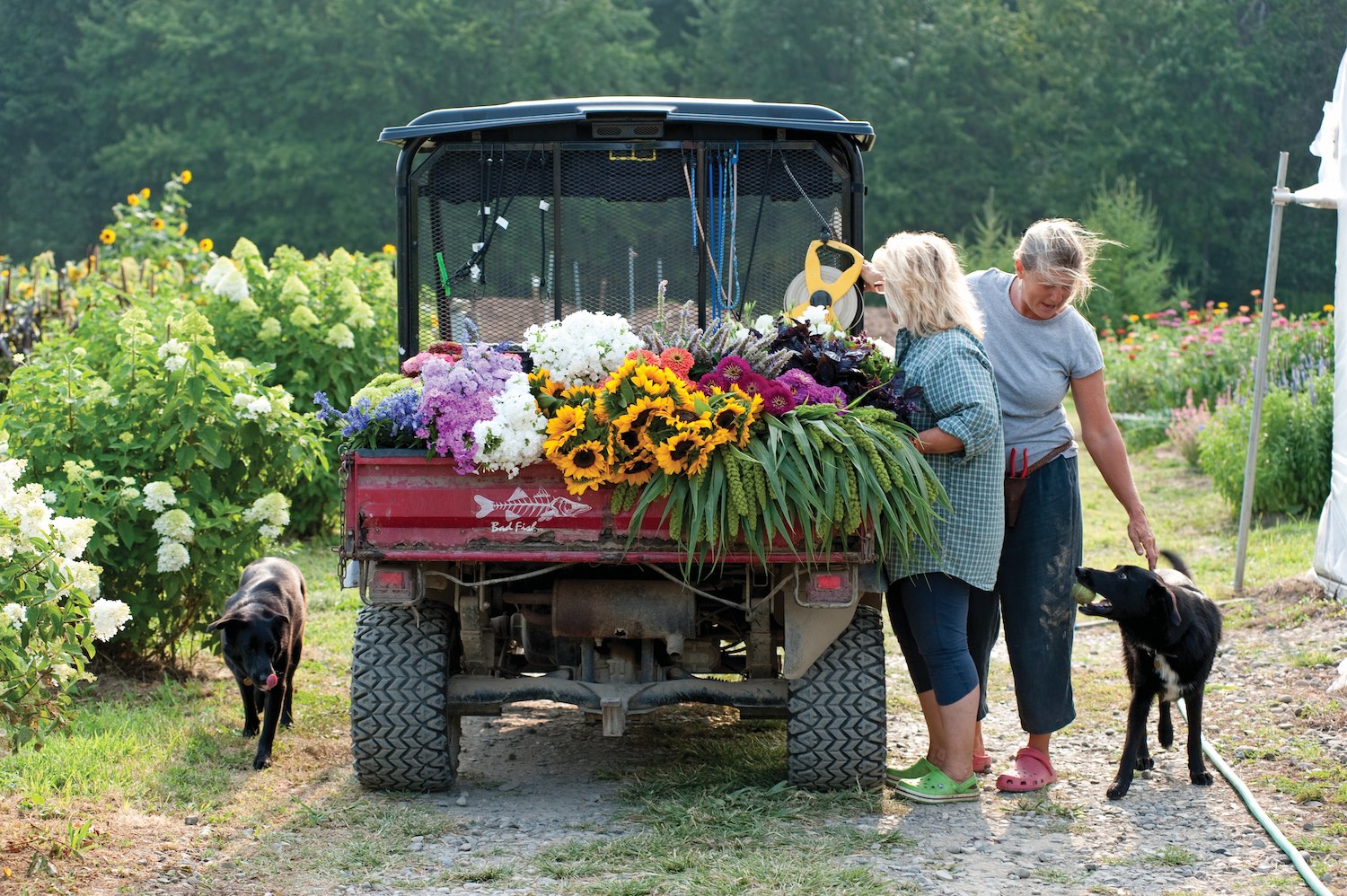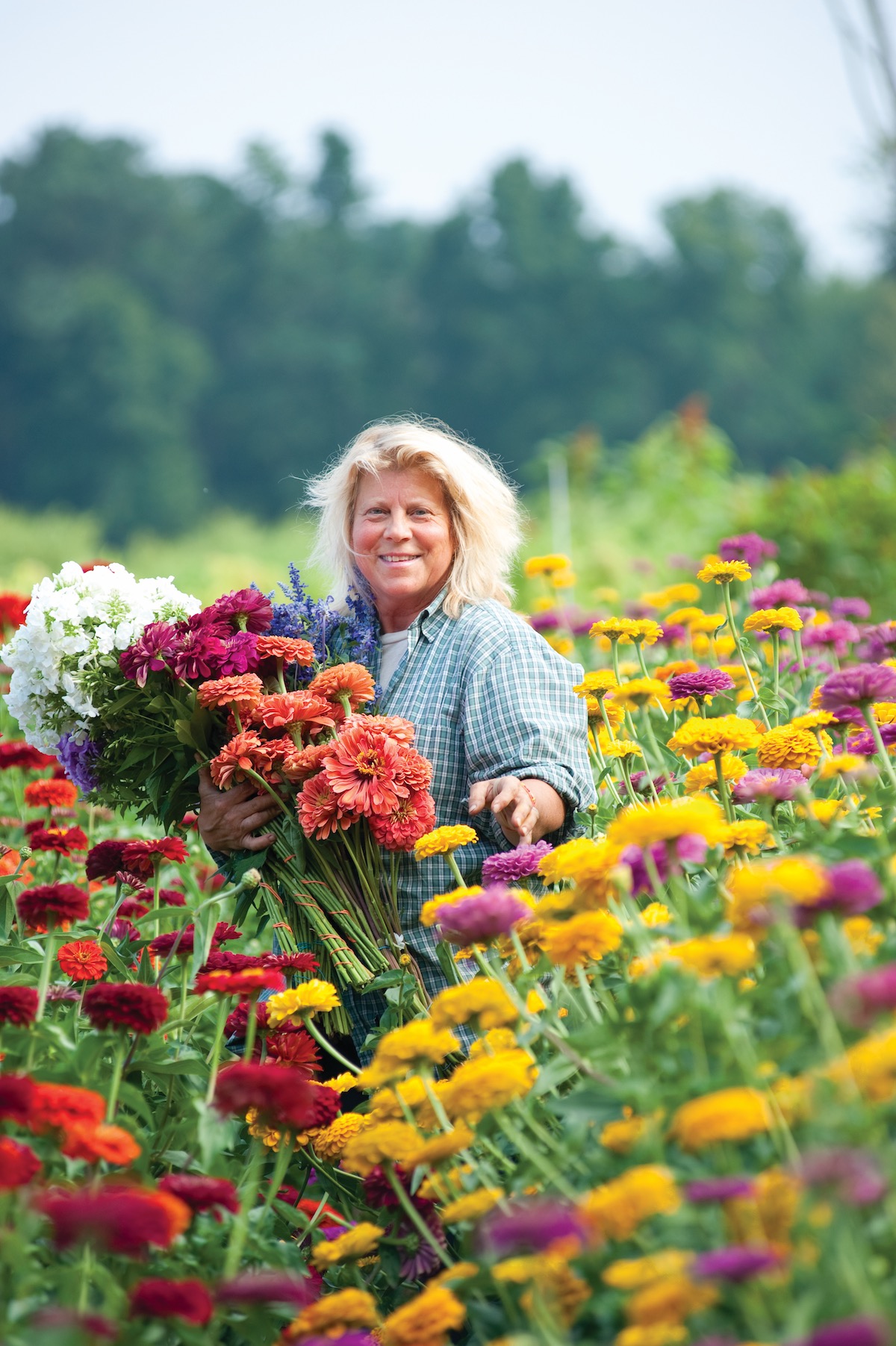
Photo by Kindra Clineff
Marilyn Cederoth (left) and Kate Swift (right) load their Kawaski mule each morning with buckets of flowers. Their dogs, Bella and Pearl— who are also sisters—are the perfect deer deterrents.
Arrive at Cedar Farm Wholesale in Ghent, New York, and chances are you’ll find Kate Swift or her sister, Marilyn Cederoth, smiling somewhere on the property. Although running a flower farm is round-the-clock hard work, you’d never know it from the sunny countenance of these two sisters. But maybe that’s because these best friends/siblings are growing dreams into reality.

Photo by Kindra Clineff
Kate Swift embraces an armful of blooms.

Photo by Kindra Clineff
Marilyn reaches for a zinnia to add to her daily pick.
Kate bores easily. And that’s how Cedar Farm Wholesale found its mojo. She loves research, can’t resist a challenge, and takes the “No Fear” approach to business. “My natural inclination is to reach for the unusual,” Kate affirms. The result is a field full of flowers that fly of the farm and into bouquets on a regular basis, but they’re not the usual inventory. In fact, a quick sweep of the field reveals that half its land is given to cut-able shrubs such as viburnums, spiraeas, hydrangeas, and physocarpus. On the rest of the acreage, there are salvias, delphiniums, zinnias, and the like. But in addition, vines (such as sweet peas and clematis) meander; vegetables (think okra, flowering cabbage, ornamental peppers) flourish; and herbs (like sage, lavender, oregano, and parsley) are major ingredients in the mix.

Photo by Kindra Clineff
Colorful rows of blooms in the fields at Cedar Farm Wholesale
Kate is a refugee from the NYC fashion industry and had already done time as a fashionista when she moved on to a farm in upstate New York with her young son. That’s when she began yearning to dig in. She’d always gardened, but never commercially. As soon as Marilyn—who spent her days behind a desk at the Chicago flower market—heard her sister say, “I should do something with the land,” she had just the solution. “Why don’t you grow flowers?” she suggested.
“At first it was just a pipe dream,” they both agreed. “But it mushroomed,” Kate says incredulously. And before long, she was inviting her sister to come and help. Marilyn didn’t need to hear the invitation twice—in 1999 she was waving goodbye to Chicago with no looking back. The combined effort led to further expansion, and in 2005 the siblings purchased a 20- acre farm perfect for their purposes, simultaneously slipping into a comfortable division of labor. Kate does the growing on 10 acres of fields and greenhouses while Marilyn handles clients—traveling around a hundred mile radius with a van full of fresh cuts three days a week. Both attend farmers markets on Saturdays.

Photo by Kindra Clineff
Ready to be delivered to area florists, some of the daily harvest includes didiscus, ageratum, salvia, agastache, sunflowers, limelight millet, mountain mint, dahlias, phlox, sedum, and lisianthus.
Actually, they wouldn’t miss the farmers markets for the world. Kate finds that her customers at the farmers markets are often refreshingly daring—eager to branch out and try more unfamiliar fare. Meeting directly with the public encourages Kate to continue blazing new trails in the cut-flower realm. Over time, Cedar Farm Wholesale has gained a reputation for its unusual inventory. As Marilyn says, “We go with what we like, instead of trying to be everything to everybody.”
Has the “buy local” movement helped? You betcha. Flowers that don’t ship well, such as dahlias, zinnias, and sweet peas are a major component of Kate and Marilyn’s business. Their field-grown, field-ripened product picked just hours before point-of-sale are “so beautiful, they’re just shining,” Kate says. “People just eat it up.”
So what’s next? Besides multistemmed, old-fashioned roses with fragrance very much intact, vines such as clematis, lots of curly willow, and red-twig dogwood, “we’re big into glads,” Kate says of what florists will be seeing in the future. Knowing that gladiolas come with baggage, she’s made it her mission to update their image, hoping that florists will follow her lead. So far, they’ve fared well at the farmers markets. Chances are, she’ll succeed with the glad goal—just as Cedar Farm convinced customers that they couldn’t live without dahlias in late summer. And she’s got a message for florists: “Be adventuresome.” Clematis will be the next little black dress of flower fashion, if Cedar Farm Wholesale has anything to do with it.



